
Pope Boniface VIII was the head of the Catholic Church and ruler of the Papal States from 24 December 1294 to his death in 1303. The Caetani family was of baronial origin, with connections to the papacy. He succeeded Pope Celestine V, who had abdicated from the papal throne. Boniface spent his early career abroad in diplomatic roles.
Pope Gregory VIII, born Alberto di Morra, was head of the Catholic Church and ruler of the Papal States for two months in 1187. Becoming Pope after a long diplomatic career as Apostolic Chancellor, he was notable in his brief reign for reconciling the Papacy with the estranged Holy Roman Empire and for initiating the Third Crusade.
Pope Stephen IX was the head of the Catholic Church and ruler of the Papal States from 3 August 1057 to his death in 29 March 1058. He was a member of the Ardenne-Verdun family, who ruled the Duchy of Lorraine, and started his ecclesiastical career as a canon in Liège. He was invited to Rome by Pope Leo IX, who made him chancellor in 1051 and one of three legates to Constantinople in 1054. The failure of their negotiations with Patriarch Michael I Cerularius of Constantinople and Archbishop Leo of Ohrid led to the permanent East-West Schism. He continued as chancellor to the next pope, Victor II, and was elected abbot of the Benedictine monastery of Montecassino.

Pope Victor III, was the head of the Catholic Church and ruler of the Papal States from 24 May 1086 to his death. He was the successor of Pope Gregory VII, yet his pontificate is far less notable than his time as Desiderius, the great abbot of Montecassino.

Pope Gregory VII, born Hildebrand of Sovana, was head of the Catholic Church and ruler of the Papal States from 22 April 1073 to his death in 1085. He is venerated as a saint in the Catholic Church.

Anagni is an ancient town and comune in the province of Frosinone, Latium, central Italy, in the hills east-southeast of Rome. It is a historical and artistic center of the Latin Valley.
Nidaros, Niðarós or Niðaróss was the medieval name of Trondheim when it was the capital of Norway's first Christian kings. It was named for its position at the mouth of the River Nid.
Anastasius Bibliothecarius or Anastasius the Librarian was bibliothecarius and chief archivist of the Church of Rome and also briefly a claimant to the papacy.

Pietro Igneo was an Italian Roman Catholic Benedictine monk from the Vallombrosians branch. He also served as a cardinal and was named as the Cardinal-Bishop of Albano. He is often referred to as a member of the Aldobrandini house but this familiar denomination is not attested in sources as a fact.
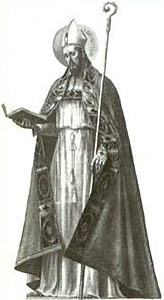
Bruno di Segni was an Italian Roman Catholic prelate and professed member from the Order of Saint Benedict who served as the Bishop of Segni and the Abbot of Montecassino. He studied under the Benedictines in Bologna before being appointed a canon of the cathedral chapter of Siena. He was invited to Rome where he became a bishop and counselled four consecutive popes. He served as an abbot in Montecassino but his chastising Pope Paschal II on the Concordat of Ponte Mammolo in 1111 prompted the pope to relieve him of his duties as abbot and order Bruno to return to his diocese, where he died just over a decade later. Bruno's canonization was celebrated on 5 September 1181 under Pope Lucius III who presided over the celebration in the late bishop's diocese.
Events from the 1230s in England.

The Diocese of Anagni-Alatri is a Latin Church ecclesiastical territory or diocese of the Catholic Church in Lazio, Italy. It has existed in its current form since 1986. In that year the Diocese of Alatri was united to the historical Diocese of Anagni. The diocese is immediately exempt to the Holy See.
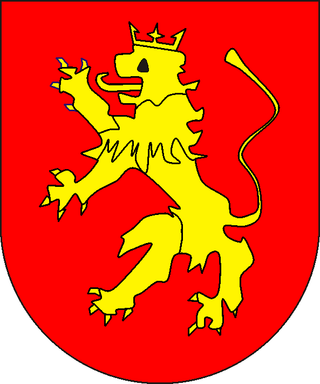
Gebhard III was Bishop of Constance and defender of papal rights against imperial encroachments during the Investiture Controversy.

Bernardo degli Uberti was an Italian Roman Catholic prelate who was a professed member and served as an abbot of the Vallumbrosan Order. Uberti served as the Bishop of Parma from 1106 until his death and was appointed as a cardinal. He came from the noble Uberti house from Florence. Uberti served as a papal legate for successive popes in several Italian regions in their disputes with secular rulers and was a close confidant and advisor to the Countess Matilda. He is often considered the third founding father for the order alongside Benedict of Nursia and Giovanni Gualberto.
Gilo of Toucy, also called Gilo of Paris or Gilo of Tusculum, was a French poet and cleric. A priest before he became a monk at Cluny, he was appointed cardinal-bishop of Tusculum sometime between 1121 and 1123. He served as a papal legate on four occasions: to Poland and Hungary around 1124, to Carinthia in 1126, to the Crusader states in 1128 or 1129 and to Aquitaine from 1131 until 1137. He took the side of the Antipope Anacletus II in the papal schism of 1130 and was deposed as cardinal-bishop by the Second Lateran Council in 1139.
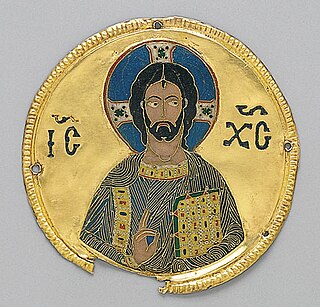
Christianity in the 11th century is marked primarily by the Great Schism of the Church, which formally divided the State church of the Roman Empire into Eastern (Greek) and Western (Latin) branches.

Altmann was the Bishop of Passau from 1065 until his death. He was an important representative of the Gregorian reforms, monastic founder and reformer. He is venerated as a saint, but not officially canonised.
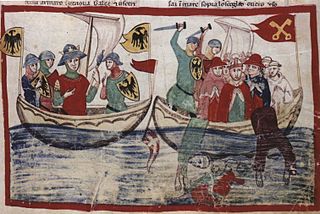
James of Pecorara or Giacomo da Pecorara was an Italian monk, cardinal and diplomat.
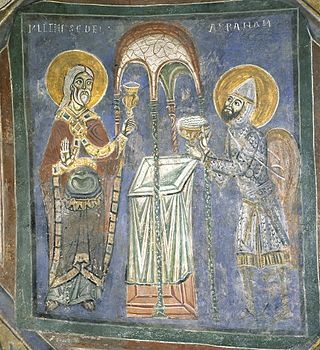
Pandulf of Anagni was an Italian cleric and military commander who became the bishop of Anagni in 1237. He came from a prominent family closely connected to a series of popes. In papal service, he led an army into the Kingdom of Sicily during the War of the Keys in 1229. As bishop, he commissioned the frescoes in the cathedral of Anagni.
Stephen of Anagni was an Italian priest in papal service.
This page is based on this
Wikipedia article Text is available under the
CC BY-SA 4.0 license; additional terms may apply.
Images, videos and audio are available under their respective licenses.












